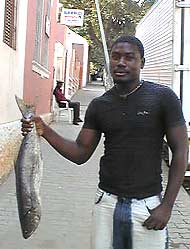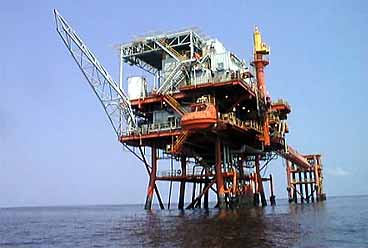How do everyday activities of oil production affect Angola's marine environment?
Like most days, it was a hot Luandan afternoon. A group of mechanics were on break. Perched on an oversized "Nido" powdered milk tin, the younger mechanic slurped from a sweating can of Sprite and passed it to a mechanic on his left. "Psst… psssssssst," he hissed. I glanced up through squinted eyes, trying to avoid the ubiquitous fine dust carried on the afternoon wind — but the mechanics' lot was free of the red clouds. The dust in the street swirled at my back, but the oil-soaked mechanics' yard remained still.
On land, oil seeps into the earth. Its polluting capacity, though harmful to the area affected, may be confined by soil absorption. In water, however, oil is not so easily contained. A small spill can spread rapidly, producing an oily layer ranging from a thin sheen to a sticky slick for miles. Given that Angola's oil production is mostly offshore, operating companies and the government have teamed up to work on strategies for containing the occasional oil spill and mitigating its impact on the marine environment.
Apart from accidents like spills and blowouts there are regular factors involved in oil production that may affect the marine environment. These can be divided into three categories according to the stage of development: drilling, production and transport. Each stage inspires questions I am trying to answer.
Drilling
 A street merchant offers fish for sale |
Compounds used to facilitate the penetration of drillbits called drilling muds were traditionally laced with heavy metals, but modern technologies have created more environmentally-friendly synthetic muds. Unfortunately, the high cost of this technology can sometimes prove prohibitive. Which muds are being used in Angola and do they contain heavy metals?
Production
After drilling the well and establishing the productive capacity of a well, it is time to "pump it up." The production process often involves injection of water and/or chemicals into the well. Though advanced centrifugal filtration techniques are used to separate the oil, chemicals and water, quantities of oil and chemicals may remain in the wastewater returned to the ocean. What is the concentration of chemicals and/or oil in this wastewater?
Both drilling and production can be energy intensive and rely on fossil fuels for energy generation. What are the emissions to air caused by the consumption of fossil fuels during exploration and production?
Although a liquid natural-gas plant will soon be constructed in Soyo, operating companies in Angola often flare the associated natural gas released during oil production, a highly-polluting activity. What are the emissions to air from flaring?
Transportation
Moving oil around can be a tricky business. Pipelines are often used for short-distance transportation. A small leak in a pipeline may go unnoticed due to minimal daily losses, but its cumulative output may cause environmental damage. What is the condition of pipeline and transportation infrastructure in Angola?
For longer distances oil is shipped by tanker. This form of transportation is rarely part of the producing company's business — the work is nearly always contracted out to another firm, which may be of dubious repute. Poorly maintained tankers can cause spills and negligent or environmentally ignorant staff may release oily bilge water in sensitive areas. Which company is transporting the oil? What are its environmental policies? What is the condition of the tanker?
Waves and currents may displace pollution from oil spills, but do the quotidian activities associated with oil production have a cumulative effect on the marine environment? Are the basic life forms like zooplankton and phytoplankton affected by oil production? Are effects felt further up the food chain, perhaps through bioaccumulation of pollutants? Or is the ocean vast enough to swallow up the cuttings, muds and compounds jettisoned in the course of production?
Are all spills reported and contained even miles out to sea where enforcement is lacking? Are environmental standards and limits on pollution maintained when the only monitoring programs are those run by the oil producing companies?
The bottom line is, does oil production have an impact on the marine environment in Angola?
If only fish could talk …
— Kristin



